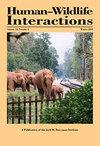黑熊非致命攻击的特征:美国,2000-2017
IF 0.9
4区 环境科学与生态学
Q4 BIODIVERSITY CONSERVATION
引用次数: 1
摘要
近几十年来,随着人类和熊的数量增加,熊(熊属)对人类的袭击有所增加。为了帮助降低未来攻击的风险,了解过去攻击的情况非常重要。关于美国黑熊(Ursus americanus)和棕熊(U. arctos)的致命攻击以及棕熊的非致命攻击的信息和分析都存在。没有类似的关于黑熊非致命攻击的全面分析。我们的研究通过分析2000年至2017年期间美国48个相邻地区黑熊的所有(n = 210)次经机构确认的非致命袭击来解决这一信息差距。大多数攻击是防御性的(52%),15%是掠食性的,33%是食物驱动的。在防御性攻击中,85%是由母熊发起的,其中91%的母熊有了孩子。在掠夺性攻击中,95%是雄性熊所为,而在食物动机攻击中,80%是雄性熊所为。母熊40%的防御性攻击与狗有关(犬类)。64%的人在袭击期间有引诱剂,74%的人表示有熊的财产损失或熊在袭击前在该地区获得食物奖励的报告。分类和回归树模型显示,严重攻击的比例最高的是与狗在一起的女性受害者,她在攻击中进行了反击。与之前关于黑熊致命攻击的研究(通常是雄性熊的掠食性攻击)相比,我们的研究结果显示了致命攻击和非致命攻击之间的明显差异。我们的研究也为狗能引发黑熊的防御性攻击这一假设提供了证据。这些结果对风险评估、减轻攻击以及我们如何建议公众应对熊的攻击具有启示意义。本文章由计算机程序翻译,如有差异,请以英文原文为准。
Characteristics of Non-Fatal Attacks by Black Bears: Conterminous United States, 2000–2017
Attacks on humans by bears (Ursus spp.) have increased in recent decades, as both human and bear populations have increased. To help mitigate the risk of future attacks, it is important to understand the circumstances in past attacks. Information and analyses exist regarding fatal attacks by both American black bears (Ursus americanus) and brown bears (U. arctos) as well as non-fatal attacks by brown bears. No similarly thorough analyses on non-fatal attacks by black bears are available. Our study addressed this information gap by analyzing all (n = 210) agency-confirmed, non-fatal attacks by black bears in the 48 conterminous United States during 2000 to 2017. Most attacks were defensive (52%), while 15% were predatory and 33% were food-motivated. Of defensive attacks, 85% were by female bears, and 91% of those females had young. Of predatory attacks, 95% were by male bears, and of food-motivated attacks, 80% were by male bears. Forty percent of defensive attacks by female bears involved dogs (Canis lupus familiaris). Sixty-four percent had an attractant present during the attack and 74% indicated there were reports of property damage by bears or of bears getting a food-reward in the area prior to the attack. A classification and regression tree model show the highest proportion of severe attacks were among a female victim who was with a dog and who fought back during an attack. When compared with previous studies of fatal attacks by black bears, which are typically predatory attacks by male bears, our results illustrate clear differences between fatal and non-fatal attacks. Our study also lends evidence to the hypothesis that dogs can trigger defensive attacks by black bears. These results have implications for risk assessment, attack mitigation, and how we advise the public to respond to an attacking bear.
求助全文
通过发布文献求助,成功后即可免费获取论文全文。
去求助
来源期刊

Human–Wildlife Interactions
Environmental Science-Nature and Landscape Conservation
CiteScore
2.80
自引率
0.00%
发文量
0
审稿时长
11 weeks
期刊介绍:
Human–Wildlife Interactions (HWI) serves the professional needs of the wildlife biologist and manager in the arena of human–wildlife conflicts/interactions, wildlife damage management, and contemporary wildlife management. The intent of HWI is to publish original contributions on all aspects of contemporary wildlife management and human–wildlife interactions with an emphasis on scientific research and management case studies that identify and report innovative conservation strategies, technologies, tools, and partnerships that can enhance human–wildlife interactions by mitigating human–wildlife conflicts through direct and indirect management of wildlife and increased stakeholder engagement. Our intent is to promote a dialogue among wildlife professionals concerning contemporary management issues. As such, we hope to provide a repository for wildlife management science and case studies that document and share manager experiences and lessons learned.
 求助内容:
求助内容: 应助结果提醒方式:
应助结果提醒方式:


